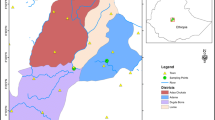Abstract
The trace metal levels in the tissues of two popular leafy vegetables Amaranthus caudatus and Corchrus olithorus widely consumed in Nigeria were assessed from a cultivated floodplain receiving effluents from diverse factories in Ibadan. Although the leaves are primarily consumed, the stems are usually used as a feed for farm animals while the roots are disposed by burning when dry or by composting. The objective of this work was to evaluate the level of trace elements in the tissues of these vegetables at harvest time when they become available to the human ecosystem for exposure to the accumulated trace metals, especially the leaves which are cooked and eaten as soup. The results of the mean trace metal levels in the analyses show that the leaves of A. caudatus had the highest bioconcentration in the following order Ba>Mn>Zn>Cu>Pb>Cr>Co>Ni>Cd>U>Sb, stems: Ba>Zn>Mn>Cu>Cr>Pb>Ni>Co>Cd>U>Sb, and roots: Mn>Ba>Zn>Cu>Cr>Pb>Ni>Co>U>Cd>Sb. In C. olithorus, the order was Mn>Ba>Zn>Cu>Pb>Cr>Co>Ni>Cd>Sb>U in the leaves, Mn>Zn>Ba>Pb>Cr>Cu>Co>Ni>U>Cd>Sb in the roots, and Mn>Zn>Ba>Cu>Cr>Pb>Co>Ni>Cd>U>Sb in the stems. The final result of the vegetable samples showed that the trace metal concentration was in the range of Cr (0.8–58.7), Mn (35.0–9,495.9), Co (0.3–33.6), Cu (2.3–60.3), Zn (16.0–538.2), Cd (0.000–40.53), Sb (0.000–0.037), Ba (13.0–1,175.6), Pb (0.9–39.7), and U (0.0–2.2). The bioconcentration factors (BF) for the transfer of trace metals from soil to the tissues showed a higher ease of bioaccumulation when compared to previous studies. The element with the highest BF in the study was Ba (6.45) in the leaves while the least was Co (0.09) in the roots of A. caudatus. The level of bioconcentration of trace metals in the leaves in most of the samples exceeds the recommended levels given by the World Health Organization (WHO) and Federal Environmental Protection Agency (FEPA), Nigeria and therefore constitutes a potential public health risk to the populace who consume these vegetables cultivated in effluent-impacted floodplains.


Similar content being viewed by others
References
Oomen HAPC, Grubben GJH (1977) Tropical leaf vegetables in Human Nutrition. Communication 69. Department of Agricultural Research Koninklijk Instituut voor de Tropen, Amsterdam
Epenhuijsen CW (1974) Growing native vegetables in Nigeria, vol 113. FAO, Rome
Tindall HD (1983) Vegetables in the tropics. Macmillan Education Ltd, London, 533 pp
Food and Agricultural Organization (1969) Home gardens for improved human nutrition (in Nigeria). Brochure: freedom from Hunger Campaign no. 39, vol 43. FAO, Rome
Nriagu JO, Pacyna JM (1988) Quantitative assessment of worldwide contamination of air, water and soils with trace metals. Nature 358:139–141
Nriagu JO (1989) A global assessment of natural sources of atmospheric trace metals. Nature 338:47–49
Kabata-Pendias A, Pendias H (1984) Trace elements in soils and plants. CRC Press, Boca Raton, Florida, USA
Voutsa D, Grimanis A, Samara C (1996) Trace elements in vegetables grown in an industrial area in relation to soil and air particulate matter. Environ Pollut 94(3):325–335
Queirolo F, Stegen S, Restovic M, Paz M, Ostapacczuk P, Schwuger MJ, Munoz L (2000) Total arsenic, lead, and cadmium levels in vegetables cultivated at the Andean Villages of Northern Chile. Sci Total Environ 255:75–84
Chamberlain AC (1983) Fall out of Pb and uptake by crops. Atmos Environ 17:693–706
Harrison RM, Chirgawi MB (1989) The assessment of air and soil as contributors of some trace metals to vegetable plants I. Use of a filtered air growth cabinet. Sci Total Environ 83:13–34
Basgel S, Erdemoglu SB (2005) Determination of mineral and trace elements in some medicinal herbs and their infusions consumed in Turkey. Sci Total Environ 359:82–89
Skinnera K, Wright N, Porter-Goffa E (2006) Mercury uptake and accumulation by four species of aquatic plants. Environ Pollut 145:7–14
Conesaa HM, Faz A, Arnaldo R (2006) Heavy metal accumulation and tolerance in plants from mine tailings of the semiarid Cartagena–La Union mining district (SE Spain). Sci Total Environ 366:1–11
Yoona J, Caoa X, Zhoub Q, Maa LQ (2006) Accumulation of Pb, Cu, and Zn in native plants growing on a contaminated Florida site. Sci Total Environ 368:456–464
Madejon P, Maranon T (2006) Biomonitoring of trace elements in the leaves and fruits of wild olive and holm oak trees. Sci Total Environ 355:187–203
Ademoroti CMA (1986) Levels of heavy metals on bark and fruit of trees in Benin City Nigeria. Intern J of Environ Pollut (series B) UK 11:241–253
Ademoroti CMA (1995) Bioaccumulation of heavy metals in some mangrove fauna and flora. (Unpublished data)
Federal Environmental Protection Agency (1991) Guideline and standards for environmental pollution control in Nigeria. FEPA, Lagos
Nriagu JO (2004) Environmental threats to children's health in Nigeria. Interdisciplinary research discourse presentation. Postgraduate School University of Ibadan on 5–8-2004
WHO/FAO (1989) Evaluation of certain food additives and contaminants. Thirty third Report of the joint FAO/WHO expert committee on food additives. WHO technical report series (Geneva) 776: 26–27
Acknowledgements
This work benefited from the University of Ibadan Staff Development/McArthur Foundation Fellowship and a laboratory space offered by Professor Jerome Nriagu, Department of Environmental Health Sciences, University of Michigan, Ann Arbor.
Author information
Authors and Affiliations
Corresponding author
Rights and permissions
About this article
Cite this article
Tyokumbur, E.T., Okorie, T. Bioconcentration of Trace Metals in the Tissues of Two Leafy Vegetables Widely Consumed in South West Nigeria. Biol Trace Elem Res 140, 215–224 (2011). https://doi.org/10.1007/s12011-010-8683-4
Received:
Accepted:
Published:
Issue Date:
DOI: https://doi.org/10.1007/s12011-010-8683-4




